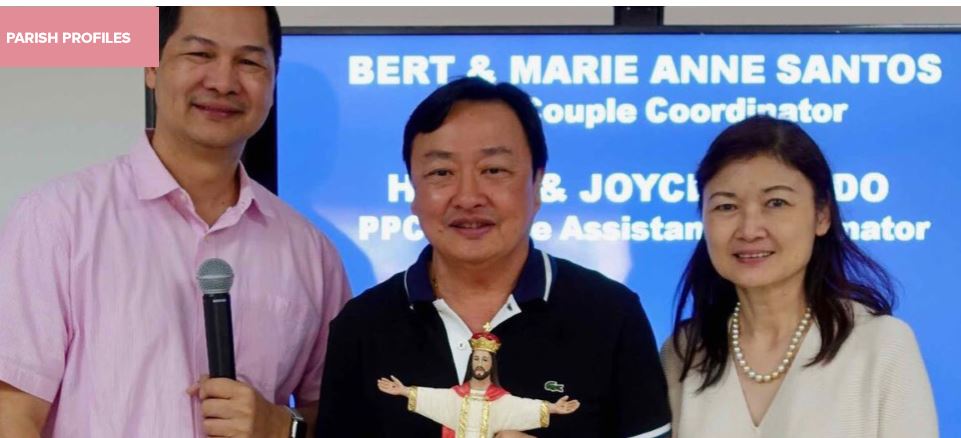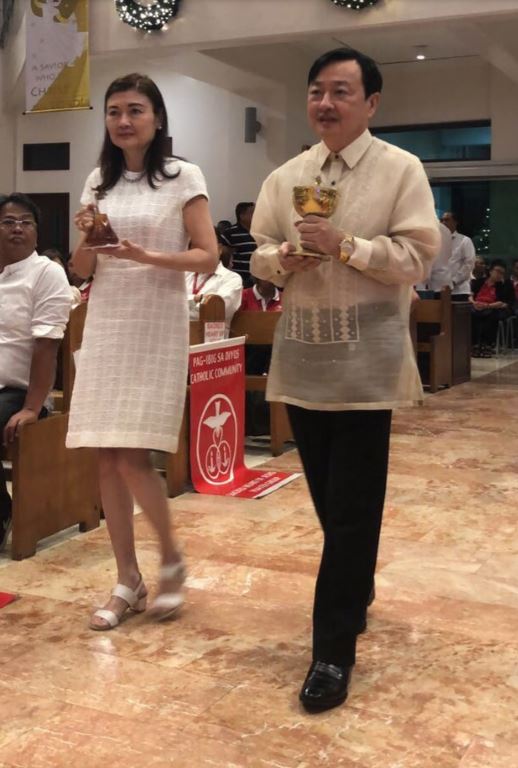Henry and Joyce Tañedo: Going Back to Basics in Community Building

“Doon tayo sa Christ the King, masarap mag-serve dun!”
These were the words of invitation that Henry Tañedo got from his friend Joe Aranas in 2005. Little did Henry know that his yes to Joe’s invitation as a Eucharistic Minister of Holy Communion (EMHC) at CTK would open a floodgate of service that surprised a lot, most especially himself.
Even if he lives in a nearby village, Henry always felt at home in CTK. He started serving during the crossroads of CTK, just when the Cubao diocese was being weaned from the Archdiocese of Manila. That was during the time when Bishop Ness Ongtioco became the “transition parish priest” of CTK.
When Fr. Bong Tupino asked Henry to head the EMHC, Henry followed in the footsteps of the priest by resorting to “food evangelization,” meaning, enticing people with a meal and conversation. Henry reminisces, “Fr. Bong brought out the best in me. He was very convincing and systematic. I could never say no whenever he approached me for a project. And he would always be very diplomatic and nurturing, even encouraging me to bring in my friends in the endeavor! It was a joy to serve with him.”
As EMHC head, Henry tried to keep up with the fervor of the other lay ministers, serving every day because they did, even if the norm was to serve one weekday and one Sunday Mass. He felt sad when the group had to retire twenty-three members because of the 75-year-old retirement age set by the diocese.
“I didn’t know a lot of parishioners then. That time I joined, there were about eighty ministers. Now they are more than 150. I crafted the guidelines, compiled manuals for liturgy, standardized the lay ministers’ uniform, and the like,” he says. He eventually ended up compiling five thick manuals for the EMHC.Henry became so enamored with serving that he even sought noontime Masses at the nearby St. John Paul II Parish at Eastwood City. “Serving makes me happy. I would attend Masses where I could find a church despite my toxic schedule—CTK, Eastwood, Padre Pio, Cardinal Santos, anywhere. My daily Mass became my armor of protection,” Henry enthuses.
Although schooled in Catholic institutions like Xavier and De La Salle, Henry had his low spells. He recalls that he never attended Mass at De La Salle. His first calling to service was when he was requested to help distribute Holy Communion by a certain Fr. Leon S.J. at Mary the Queen parish near Xavier School. He felt unworthy and was embarrassed to be clothed in “shocking yellow”! But the experience obviously touched him more than he knew. Years later, he became a member of the covenanted Catholic community, Pagibig ng Diyos, where he says his spirituality deepened. He thought at first that after the three days of the session, that would be it. But the Lord had other plans. He and spouse, Joyce were chosen as coordinators and they found themselves attending
prayer meetings, even if it ran into conflict with his regular Wednesday basketball practice. For Henry, that was a major shift.
Henry is the type who gives himself odd challenges and goes by signs. He challenged himself to go to Mass for a month straight at CTK before he plunged into serving. He ended up attending daily Mass way beyond the thirty days. He challenged himself to sink golf balls at a driving range as a sign that it was right to accept his post in the parish. Well, the ball sank not just once, but thrice and more. The “signs” were just too clear. He had his share of personal trials, some too painful to recount. A father of five, there was a time when problems brought him to tears during Mass. There was even a time when their family was not at all “religious,” with Sunday Mass being the last priority. It was lucky if they attended Christmas Mass at all.
But all that changed with his involvement with Pag-ibig sa Diyos and CTK. Today, Henry and Joyce, together with Father Steve, are at the forefront of the Coffee Talk series of consultations with the different ministries and organizations aiming to animate the parish. Among their priorities as PPC heads is how to make the PPC more accessible, bring the community to active participation in the parish. He is convinced the way to do that is to make sure “people see God in us.” Henry and Joyce are continually inspired by the generous CTK community. He hopes people will know and care more about each other despite the high village fences. He is challenged by the work ahead, especially since the parish is celebrating its fortieth anniversary. But most of all, Henry and Joyce and are humbled by the position of being lead servant couple in an amazing stewardship parish such as CTK.
Once reluctant servant leaders, Henry and Joyce are inspired by one thing: “Nobody can separate us from Christ anymore.”

